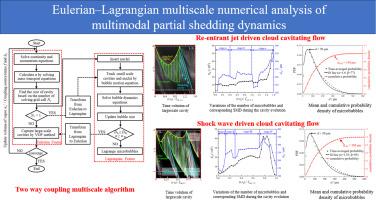The objective of this paper is to investigate the multimodal partial shedding dynamics from a multiscale perspective of cloud cavitating flows under two distinct cavity shedding mechanisms, namely the re-entrant jet mechanism and the shock wave propagation mechanism. A two-way Eulerian–Lagrangian coupling algorithm is applied to capture the multiscale vapor topologies from microbubble to large-scale cavities. The large-scale cavity evolution is solved through large eddy simulations (LES) with the volume of fraction (VOF) method in Eulerian frame. The sub-grid microbubbles are tracked in Lagrangian frame based on the discrete bubble model (DBM) method. The predictions agree well with experimental observation of the periodical cavity evolution and microbubble dynamics under both the re-entrant jet mechanism and shock wave mechanism around a NACA66 hydrofoil. The numerical simulation provides detailed analysis of the cavitating turbulent flow on the microbubble behavior with emphasis on the spatial-temporal distribution characteristics of microbubbles. The results show that the number and mean size of microbubbles in the cavitation region increase gradually with the growth of attached sheet cavity, development of re-entrant jet and collapse of largescale cavity for both cavitation patterns. Meanwhile, microbubbles are mainly distributed on the largescale interfaces where have high value of vorticity and turbulent kinetic energy under the effect of re-entrant jet and vortex structures. And the probability density functions (PDFs) of microbubble exhibit gamma distributions with a dominant peak at approximately 50 μm for both shedding mechanisms. However, the shock wave formation and propagation process only occurs in the final stage of cavitating flow under shock wave mechanism causing the condensation of vapor and the decrease of the number and mean size of microbubbles. Moreover, the microbubbles are uniformly distributed along the streamwise and vertical directions behind shock wave front.


